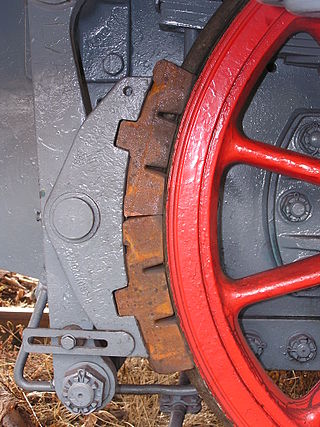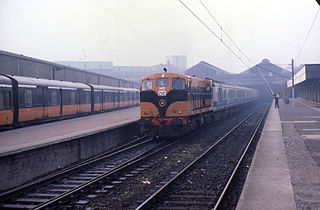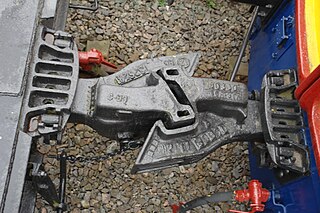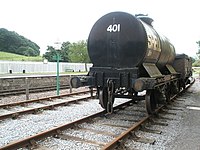The Armagh rail disaster happened on 12 June 1889 near Armagh, County Armagh, in Ireland, when a crowded Sunday school excursion train had to negotiate a steep incline; the steam locomotive was unable to complete the climb and the train stalled. The train crew decided to divide the train and take forward the front portion, leaving the rear portion on the running line. The rear portion was inadequately braked and ran back down the gradient, colliding with a following train.

Brake van and guard's van are terms used mainly in the UK, Ireland, Australia and India for a railway vehicle equipped with a hand brake which can be applied by the guard. The equivalent North American term is caboose, but a British brake van and a caboose are very different in appearance, because the former usually has only four wheels, while the latter usually has bogies. German railways employed brakeman's cabins combined into other cars.
Rail transport terms are a form of technical terminology applied to railways. Although many terms are uniform across different nations and companies, they are by no means universal, with differences often originating from parallel development of rail transport systems in different parts of the world, and in the national origins of the engineers and managers who built the inaugural rail infrastructure. An example is the term railroad, used in North America, and railway, generally used in English-speaking countries outside North America and by the International Union of Railways. In English-speaking countries outside the United Kingdom, a mixture of US and UK terms may exist.

The British Rail Class 73 is a British electro-diesel locomotive. The type is unusual in that it can operate from the Southern Region's 650/750 V DC third-rail or an on-board diesel engine to allow it to operate on non-electrified routes. This makes it very versatile, although the diesel engine produces less power than is available from the third-rail supply so the locomotives are rarely operated outside of the former Southern Region of British Rail. It is one of the first bi-mode locomotives ever built. Following the withdrawal and scrapping of the more powerful Class 74 bi-mode locomotives in 1977, the Class 73 was unique on the British railway network until the introduction of the Class 88 bi-mode locomotives in 2017. Ten locomotives have been scrapped.

A coupling or coupler is a mechanism, typically located at each end of a rail vehicle, that connects them together to form a train. The equipment that connects the couplers to the vehicles is the draft gear or draw gear, which must absorb the stresses of the coupling and the acceleration of the train.

A railway brake is a type of brake used on the cars of railway trains to enable deceleration, control acceleration (downhill) or to keep them immobile when parked. While the basic principle is similar to that on road vehicle usage, operational features are more complex because of the need to control multiple linked carriages and to be effective on vehicles left without a prime mover. Clasp brakes are one type of brakes historically used on trains.

Shunting, in railway operations, is the process of sorting items of rolling stock into complete trains, or the reverse. In the United States this activity is known as switching.

A buffer is a part of the buffers-and-chain coupling system used on the railway systems of many countries, among them most of those in Europe, for attaching railway vehicles to one another.

London Underground battery-electric locomotives are battery locomotives used for hauling engineers' trains on the London Underground network where they can operate when the electric traction current is switched off. The first two locomotives were built in 1905 for the construction of the Great Northern, Piccadilly and Brompton Railway, and their success prompted the District Railway to buy two more in 1909, which were the only ones built to the loading gauge of the subsurface lines. Following this, a number of battery vehicles were built by converting redundant motor cars, with the batteries placed in the unused passenger compartment. One exception to this was made by the City and South London Railway, who used a trailer car to hold the batteries, and wired them to a separate locomotive.
Type H Tightlock couplers are a variety of Janney coupler, typically used on North American mainline passenger rail cars. They have mechanical features that reduce slack in normal operation and prevent telescoping in derailments, yet remain compatible with other Janney types used by North American freight railroads.

SA3 couplers or Willison coupler and Russian coupler are railway couplings used primarily in Russia and states influenced by the former Soviet Union, such as Finland, Poland, and Mongolia.
In railroading, slack action is the amount of free movement of one car before it transmits its motion to an adjoining coupled car. This free movement results from the fact that in railroad practice cars are loosely coupled, and the coupling is often combined with a shock-absorbing device, a "draft gear", which, under stress, substantially increases the free movement as the train is started or stopped. Loose coupling is necessary to enable the train to bend around curves and is an aid in starting heavy trains, since the application of the locomotive power to the train operates on each car in the train successively, and the power is thus utilized to start only one car at a time.
The railcar couplers or couplings listed, described, and depicted below are used worldwide on legacy and modern railways. Compatible and similar designs are frequently referred to using widely differing make, brand, regional or nick names, which can make describing standard or typical designs confusing. Dimensions and ratings noted in these articles are usually of nominal or typical components and systems, though standards and practices also vary widely with railway, region, and era. Transition between incompatible coupler types may be accomplished using dual couplings, a coupling adapter or a barrier wagon.

A barrier vehicle (BV), barrier wagon, match wagon or translator coach is used to convert between non-matching railway coupler types. This allows locomotives to pull railway vehicles or parts of a train with a different type of coupler. A match wagon has an identical dual coupling at both ends.
Janney couplers are a semi-automatic form of railway coupling that allow rail cars and locomotives to be securely linked together without rail workers having to get between the vehicles. They are also known as American, AAR, APT, ARA, MCB, knuckle, Buckeye, tightlock or Centre Buffer Couplers.

A Norwegian coupling or coupler, is a manually operated coupling at each end of some narrow-gauge railway rolling stock. It consists of a central buffer incorporating a hook that drops into a slot in the opposing central buffer. The system is only found on narrow gauge railways with a gauge of 1067 mm or less on which low speeds and train loads allow a simpler system than, for example, knuckle couplers. Norwegian couplings are not particularly strong, and may be supplemented by auxiliary chains. Not all Norwegian couplings are compatible with one another since they vary in height and width. Some may permit a hook from both rail vehicles to be in place; others may be limited to one.
From time to time, a railway decides that it needs to upgrade its coupling system from one that is proving unsatisfactory, to another that meets future requirements. This can be done gradually, which can create many problems with transitional incompatibilities, or overnight, which requires much planning.

Different types of railroad rolling stock have different couplers depending on the purpose and type of equipment being used and its intended destination. European rolling stock tend to use buffers and chain couplers while American rolling stock uses a Janney coupler or "knuckle coupler". These are incompatible with each other, but where some railroads have obtained older, less expensive used rolling stock from different countries or regions, instead of having to standardize on one form of coupler, it may be useful to be able to use either type of coupler on a piece of rolling stock without having to remove anything.

British Railways inherited a variety of brake vans from each of the Big Four: GWR, LNER, Southern Railway and LMS due to the nationalisation of the railways in 1948.

The balance lever coupling, also known as rocking lever coupling or compensating coupling, is a type of central buffer coupling that has found widespread use, especially in narrow-gauge railways. In Switzerland this type of coupling is called a central buffer with two screw couplings, abbreviated to Zp2, or referred to as a central buffer coupling with coupling hooks on the side
























